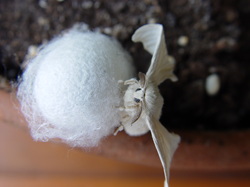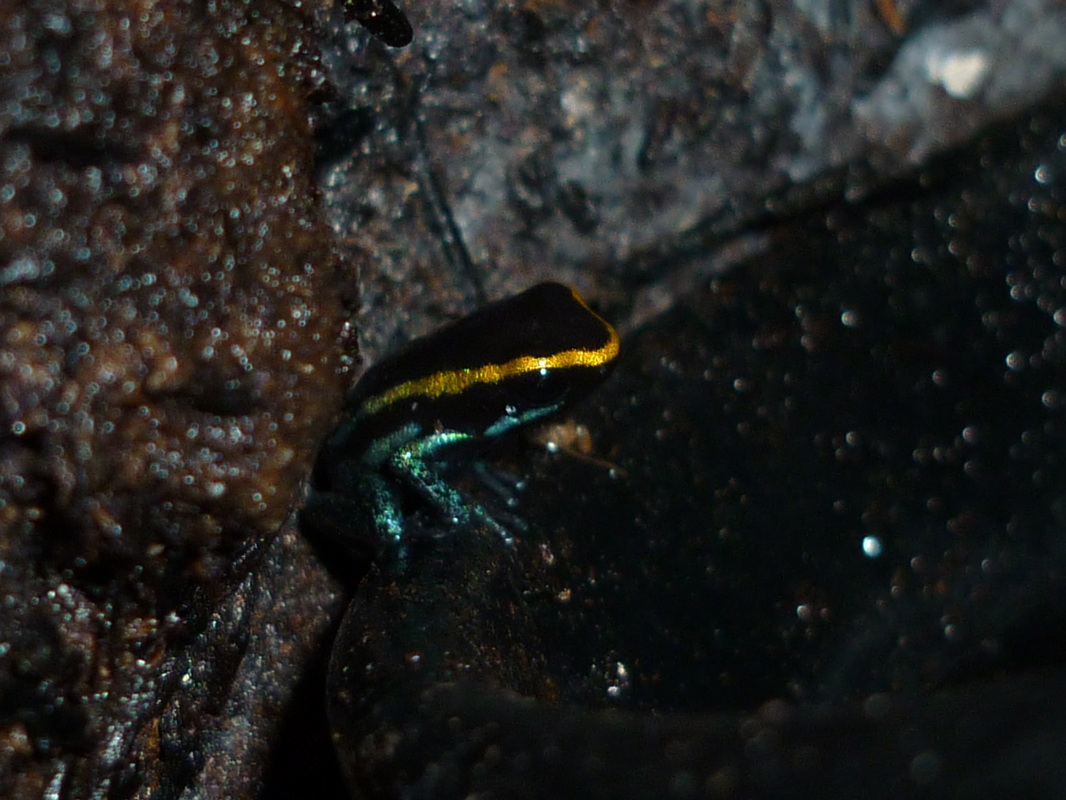|
Ask any of my friends or colleagues and everybody will testify: I'm a gadget freak. So when a twitter post mentioned something called iPipet, I just had to delve into it as the "i" sounded gadgety and the "pipet" referred to laboratory equipment. So, what's it about?
1 Comment
Something different than research this time... I found a baby frog in my paludarium! This means that I have created the right circumstances not only for mating but also for the developing tadpoles. Until now I have found tadpoles deposited in plant jars and I took them out into a separate tank (see section Breeding), but this time a spotted a tiny frog on the rim of one of the plant jars! Apparently, the automated rain system works wonderfully in keeping the tank moist, and most importantly, maintaining a minimum water level in the bromelias. In addition, I also found two new tadpoles in a jar and I have transferred them to the breeding tank.
In the pictures below the baby frog. Isn't he cute?
The Society for Molecular Biology and Evolution (SMBE) is a society aimed at providing "facilities for association and communication among molecular evolutionists and to further the goals of molecular evolution, as well as its practitioners and teachers". They organize an annual conference each year in a different country, even on different continents were possible. Last time I went there, in 2010, it was organized in Lyon and after abstract submission I was invited to present my research. I even got a travel grant!
 Bombyx mori, or the domesticated silkworm has been used for over 5000 years for the production of silk. Male silkworms are a bit better at producing high quality silk so breeders have been wanting to breed only males for a long time. Knowledge of the sex determining system is then convenient but the mechanism of sex determination in silkworms has eluded scientist for a long time.  All organisms on earth carry a blue-print of their construction in each cell. This blue-print is a genetic code written into either RNA or DNA and this code is transmitted to the next generation. Only viruses contain RNA, all other organisms contain DNA in every cell which is made up by four bases: guanine, cytosine, adenine and thymine. As seen in the figure, these bases form stable basepair bridges linking the two DNA strands together. Adenine only basepairs with thymine and guanine basepairs only with cytosine. All the cellular components required for copying DNA or translating the DNA code into proteins have only ever worked with the GATC bases.  When talking or reading about pyrosequencing you're probably thinking immediately of the high-throughput 454 sequencing. This sequencing technique is based on the "sequencing by synthesis" principle and differs radically from the standard Sanger sequencing. It can be viewed as the qPCR version of standard PCR. This technique was commercialized by Pyrosequencing AB and has been further developed for high throughput sequencing by 454 Life Sciences. Qiagen acquired the pyrosequencing business line in 2008 and started developing the pyrosequence technique for low/medium throughput applications. So, even though it is based on the same technology (see video below), the pyrosequencing I am talking about here is NOT the 454 system but the Qiagen system!  A little over a year ago, Louis van de Zande and me were kindly invited to guest edit a special issue on insect sex determination. This special issue in Sexual Development titled: "Sex Determination and Differentiation in Insects has now been published! But, no special issue could be here today without the fantastic articles contributed by all the authors. Thank you! In addition, thank you Sexual Development for this great opportunity and in particular, the editor, Michael Schmid for the support during the production phase! I'm very proud of this issue and I hope that it will be of great interest to the reader. The entire issue can be found here.  Ever since I work in science, I've had issues with the "pressure to publish as much as you can". Apparently, real curiosity driven questions seem no longer the aim of science, just the quick (and dirty) research that will yield an easy publication. It bothers me because I feel that I'm already thinking about my own research in terms of publications and not in terms of research questions that I would like to investigate. In addition this pressure likely leads to publications that are shaky to say the least or downright fraudulent. But finally! Productivity is no longer a criterion to distinguish the good researchers from the bad, as can be read in a press statement on the website of the KNAW. This criterion has been removed from the Standard Evaluation Protocol (SEP) which is drafted by the three big scientific organisations in the Netherlands: KNAW, NWO and VSNU. Now only "scientific quality", "social relevance" and being "future proof" are the criteria to measure researchers qualities. Social relevance as a criterion for science and researchers is yet another issue that could better be removed from the SEP, but that is for another discussion. What do you think? Since a short while I have a Twitter account, mainly to keep track of interesting new publications. This time it served me well, because I noticed the tweet about a mimicry supergene. Immediatly this struck my attention because I was directly thinking that Doublesex could have something to do with it, which is the case! This highly interesting paper by Kunte et al. 'Doublesex is a mimicry supergene' is published online in Nature. In short, the butterfly Papilio polytes displays female specific mimicry, meaning that female of this species mimic the appearance of a toxic butterfly genus, Pachliopta. For a long while it has been thought that this type of mimicry is controlled by a 'supergene', and in this publication the authors show that differences in isoform expression and multiple polymorphisms in Doublesex are at the basis of the different female forms. This resembles the level of control of Doublesex in Nasonia. In a study by Loehlin et al. (that I have been involved in) we demonstrate that different expression levels of doublesex control the sex and species specific differences in wing length found in the Nasonia genus. By the way, Loehlin together with Carroll also wrote the Nature News & Views 'Sex lies and butterflies' on the butterfly mimicry topic. It is this type of research that excites me! Doublesex is the the conserved master-switch in insect sex determination regulating the male and female morphologies. But it does so much more! While maintaining its sex determination function, it also seems to control a wide variety of species specific morphologies! Doublesex does it all! In addition to my somewhat static website where you can read about about me and my research, I would also like to share some more... In this blog I would like to give my slice of science by sharing observations on science in general, research on insect sex determination, but also struggles in the lab.
In addition you can read about some highlights from my personal life which will be mostly centred around my slice of nature at home, i.e. the paludarium and the breeding of frogs. These different posts will be categorised so it should be easy for you to find them! I'm not the best writer in the world but hopefully this will improve somewhat. I hope that my posts are of interest to you and please leave some comments (positive or negative) on my website and my blogs via the contact form, or any of the social media that I use. If you would like to get in contact with me about research you're welcome to also use the contact form, email or social media. Happy reading! |
Archives
September 2018
Categories
All
|






 RSS Feed
RSS Feed






